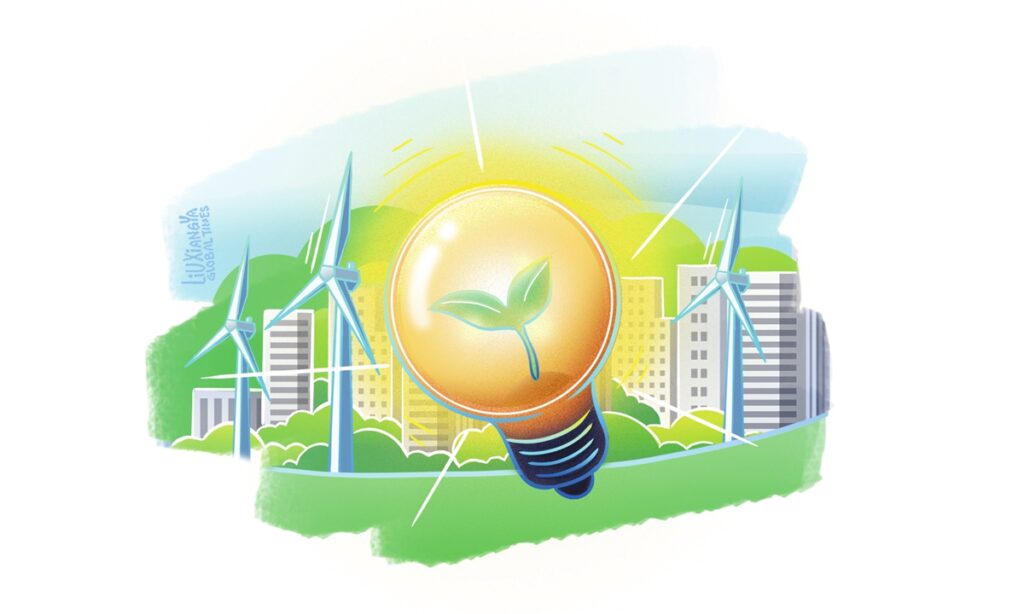China’s wind power sector, renowned for its impressive advancements, is steadily emerging as a pivotal driver in the global energy transition. By leveraging international cooperation models like South-South cooperation, Chinese wind power companies can overcome international trade barriers while playing a crucial role in optimizing the global energy landscape.
Qin Haiyan, secretary-general of the Chinese Wind Energy Association under the China Renewable Energy Society, said on Saturday that China built and connected 88 million kilowatts of wind power to its national grid in 2024, with newly installed capacity expected to reach 105 million to 115 million kilowatts in 2025. In 2024, China’s wind turbines exports reached about 5.5 gigawatts, with shipments sent to 24 countries, Chinese financial news portal cls.cn reported.
Each segment of China’s wind power industrial chain accounts for more than 60 percent of the global market, positioning the sector to seize significant opportunities for international expansion, Qin noted.
These figures not only underscore China’s strong capabilities and leading position in the global wind power sector, but also suggest that the global utilization of wind energy will significantly hinge on China’s performance and contributions.
The reason why China’s wind power sector can hold such an important position in the global market is due to its consistent investment and innovation in the renewable energy sector. Over the years, the Chinese government and companies have prioritized the development of renewable energy, fostering rapid growth through policy guidance, technological innovation and continuous improvement of market mechanisms. This sustained effort and innovation have endowed China’s wind power industry with strong competitiveness in the global market, achieving significant accomplishments in terms of technological level, industry chain completeness and cost controls.
According to data from the Abu Dhabi-based International Renewable Energy Agency between 2010 and 2023, the global weighted average levelized cost of electricity of onshore wind fell 70 percent, and the average capital costs of the construction of solar power plants fell by more than 80 percent over the past decade. Green power generation costs fell rapidly thanks to economies of scale, which was largely attributed to the production increase in China’s renewable energy sector.
In the past, the West often accused China of relying too heavily on coal. However, with China’s rapid development in the renewable energy sector, it has begun to criticize China for exporting too many green products. This criticism actually reflects the Western anxiety over their setbacks in the energy transition. Many Western countries are hindered by factors such as commercial interests and geopolitical issues, resulting in slow progress in the energy transition. After the outbreak of the Russia-Ukraine conflict, energy prices in many European countries soared, and some countries even restarted coal-fired power facilities that had previously been shut down.
By comparison, China has made solid progress in its energy transition. For instance, China’s combined installed capacity of wind and solar power surpassed that of its coal power for the first time at the end of June 2024, data from the China Electricity Council showed.
Since 2013, the country’s installed wind power capacity has grown sixfold, and its installed solar power capacity has surged more than 180-fold. New installations in China account for more than 40 percent of the global annual total, contributing significantly to the world’s green development, according to the Xinhua News Agency.
Fatih Birol, executive director of the International Energy Agency, said in October 2024 that “We are now in a world where almost every energy story is essentially a China story.”
However, the global expansion of China’s wind power sector faces challenges. Chinese wind power companies often encounter barriers and unfair treatment in international trade, which undoubtedly increase the difficulty and cost of entering overseas markets.
Against this backdrop, South-South cooperation has become an important way for Chinese wind power companies to seek new markets and opportunities.
The increasing demand for clean energy in developing countries is accompanied by challenges in technology, funding and industrial support, which align well with the strengths of China’s wind power industry.
Through South-South cooperation, Chinese wind power companies can bring advanced technology and experience to developing countries, helping them achieve an energy transformation and green development. At the same time, cooperation with developing countries also helps Chinese wind power companies break through international trade barriers, further promoting the extension and improvement of China’s wind power industrial chain.
GT




